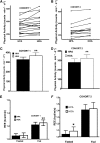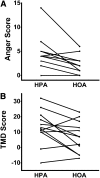Substituting dietary monounsaturated fat for saturated fat is associated with increased daily physical activity and resting energy expenditure and with changes in mood
- PMID: 23446891
- PMCID: PMC3607650
- DOI: 10.3945/ajcn.112.051730
Substituting dietary monounsaturated fat for saturated fat is associated with increased daily physical activity and resting energy expenditure and with changes in mood
Erratum in
- Am J Clin Nutr. 2013 Aug;98(2):511
Abstract
Background: The Western diet increases risk of metabolic disease.
Objective: We determined whether lowering the ratio of saturated fatty acids to monounsaturated fatty acids in the Western diet would affect physical activity and energy expenditure.
Design: With the use of a balanced design, 2 cohorts of 18 and 14 young adults were enrolled in separate randomized, double-masked, crossover trials that compared a 3-wk high-palmitic acid diet (HPA; similar to the Western diet fat composition) to a low-palmitic acid and high-oleic acid diet (HOA; similar to the Mediterranean diet fat composition). All foods were provided by the investigators, and the palmitic acid (PA):oleic acid (OA) ratio was manipulated by adding different oil blends to the same foods. In both cohorts, we assessed physical activity (monitored continuously by using accelerometry) and resting energy expenditure (REE). To gain insight into a possible mood disturbance that might explain changes in physical activity, the Profile of Mood States (POMS) was administered in cohort 2.
Results: Physical activity was higher during the HOA than during the HPA in 15 of 17 subjects in cohort 1 (P = 0.008) (mean: 12% higher; P = 0.003) and in 12 of 12 subjects in the second, confirmatory cohort (P = 0.005) (mean: 15% higher; P = 0.003). When the HOA was compared with the HPA, REE measured during the fed state was 3% higher for cohort 1 (P < 0.01), and REE was 4.5% higher in the fasted state for cohort 2 (P = 0.04). POMS testing showed that the anger-hostility score was significantly higher during the HPA (P = 0.007).
Conclusions: The replacement of dietary PA with OA was associated with increased physical activity and REE and less anger. Besides presumed effects on mitochondrial function (increased REE), the dietary PA:OA ratio appears to affect behavior. The second cohort was derived from a study that was registered at clinicaltrials.gov as R01DK082803.
Trial registration: ClinicalTrials.gov NCT01612234.
Figures


Similar articles
-
Dietary saturated fat and monounsaturated fat have reversible effects on brain function and the secretion of pro-inflammatory cytokines in young women.Metabolism. 2016 Oct;65(10):1582-8. doi: 10.1016/j.metabol.2016.08.003. Epub 2016 Aug 9. Metabolism. 2016. PMID: 27621193 Free PMC article. Clinical Trial.
-
Dietary intake of palmitate and oleate has broad impact on systemic and tissue lipid profiles in humans.Am J Clin Nutr. 2014 Mar;99(3):436-45. doi: 10.3945/ajcn.113.070557. Epub 2014 Jan 15. Am J Clin Nutr. 2014. PMID: 24429541 Free PMC article. Clinical Trial.
-
Increasing dietary palmitic acid decreases fat oxidation and daily energy expenditure.Am J Clin Nutr. 2005 Aug;82(2):320-6. doi: 10.1093/ajcn.82.2.320. Am J Clin Nutr. 2005. PMID: 16087974 Free PMC article. Clinical Trial.
-
Effects of dietary fatty acid composition on 24-h energy expenditure and chronic disease risk factors in men.Am J Clin Nutr. 2009 May;89(5):1350-6. doi: 10.3945/ajcn.2008.27419. Epub 2009 Mar 25. Am J Clin Nutr. 2009. PMID: 19321562 Free PMC article.
-
A new frontier for fat: dietary palmitic acid induces innate immune memory.Immunometabolism (Cobham). 2023 May 15;5(2):e00021. doi: 10.1097/IN9.0000000000000021. eCollection 2023 Apr. Immunometabolism (Cobham). 2023. PMID: 37197687 Free PMC article. Review.
Cited by
-
Association between ultra-processed dietary pattern and bullying: the role of deviant behaviors.Front Nutr. 2024 Jul 4;11:1352258. doi: 10.3389/fnut.2024.1352258. eCollection 2024. Front Nutr. 2024. PMID: 39027661 Free PMC article.
-
Hypolipidemic effect and modulation of hepatic enzymes by different edible oils in obese Wistar rats.Heliyon. 2024 Feb 10;10(4):e25880. doi: 10.1016/j.heliyon.2024.e25880. eCollection 2024 Feb 29. Heliyon. 2024. PMID: 38384579 Free PMC article.
-
Multi-omics reveal neuroprotection of Acer truncatum Bunge Seed extract on hypoxic-ischemia encephalopathy rats under high-altitude.Commun Biol. 2023 Oct 2;6(1):1001. doi: 10.1038/s42003-023-05341-9. Commun Biol. 2023. PMID: 37783835 Free PMC article.
-
Restricting sugar or carbohydrate intake does not impact physical activity level or energy intake over 24 h despite changes in substrate use: a randomised crossover study in healthy men and women.Eur J Nutr. 2023 Mar;62(2):921-940. doi: 10.1007/s00394-022-03048-x. Epub 2022 Nov 3. Eur J Nutr. 2023. PMID: 36326863 Free PMC article. Clinical Trial.
-
Regulation of Voluntary Physical Activity Behavior: A Review of Evidence Involving Dopaminergic Pathways in the Brain.Brain Sci. 2022 Mar 1;12(3):333. doi: 10.3390/brainsci12030333. Brain Sci. 2022. PMID: 35326289 Free PMC article. Review.
References
-
- Berglund L, Lefevre M, Ginsberg HN, Kris-Etherton PM, Elmer PJ, Stewart PW, Ershow A, Pearson TA, Dennis BH, Roheim PS, et al. Comparison of monounsaturated fat with carbohydrates as a replacement for saturated fat in subjects with a high metabolic risk profile: studies in the fasting and postprandial states. Am J Clin Nutr 2007;86:1611–20 - PubMed
-
- Ravussin E, Lillioja S, Knowler WC, Christin L, Freymond D, Abbott WGH, Boyce V, Howard BV, Bogardus C. Reduced rate of energy expenditure as a risk factor for body-weight gain. N Engl J Med 1988;318:467–72 - PubMed
-
- Levine JA, Lanningham-Foster LM, McCrady SK, Krizan AC, Olson LR, Kane PH, Jensen MD, Clark MM. Interindividual variation in posture allocation: possible role in human obesity. Science 2005;307:584–6 - PubMed
Publication types
MeSH terms
Substances
Associated data
Grants and funding
LinkOut - more resources
Full Text Sources
Other Literature Sources
Medical


